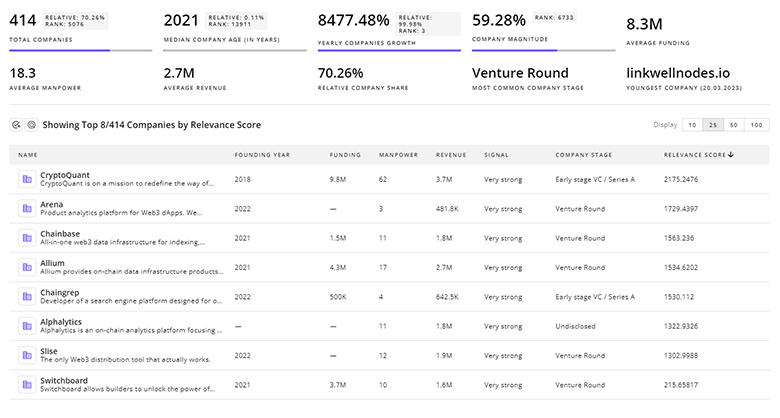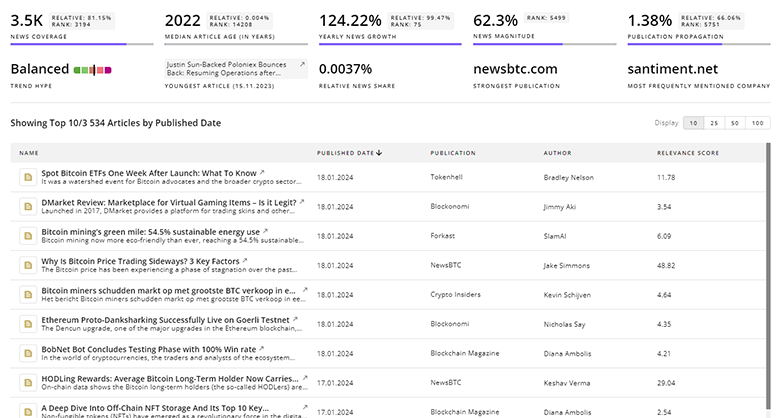
Vertical Take-off And Landing Report
: Analysis on the Market, Trends, and TechnologiesThe vertical take-off and landing (VTOL) market is moving from experimentation toward commercial scale, with the internal trend data projecting a market size of US $9.23 billion in 2025 and a forecast of US $17.29 billion by 2029, driven by rising electric and hybrid propulsion adoption, defense demand, and vertiport expansion Vertical Take-Off and Landing (VTOL) UAV Market Report 2025. Regulatory alignment, increased airline and logistics commitments, and a steady cadence of flight demonstrations are shortening commercialization timelines and shifting investment from R&D toward certification and infrastructure deployment.
32 days ago, we last updated this report. Notice something that’s not right? Let’s fix it together.
Topic Dominance Index of Vertical Take-off And Landing
The Topic Dominance Index offers a holistic analysis of Vertical Take-off And Landing, merging data from 3 diverse sources: relevant published articles, newly founded companies, and global search metrics.
Key Activities and Applications
- Urban air mobility (passenger eVTOL / air taxi): Short-range passenger operations and airport feeders are the principal near-term commercial use case, with manufacturers and operators working toward pilot-in-command services and staged rollout plans.
- Regional airline feeder and point-to-point routes: Airlines and regional operators are placing firm orders and trialing aircraft to replace or augment turboprops on short routes.
- Cargo, middle-mile and last-mile logistics: Autonomous and piloted VTOLs are being developed for time-sensitive deliveries and hard-to-reach locations; heavy-lift variants extend this to middle-mile flows.
- Defense, ISR and loyal-wingman/autonomous platforms: Military programs emphasize runway-independent logistics, ISR and high-performance unmanned VTOLs that combine jet propulsion with advanced autonomy.
- Emergency medical services and disaster response: VTOLs offer rapid patient transport and access to constrained sites; pilots and autonomous variants are being tested for medevac and SAR roles.
- Infrastructure inspection and industrial services: VTOL UAVs deliver inspection payloads (LiDAR, high-res cameras) with hover capability, reducing on-site risk and mobilization cost.
Emergent Trends and Core Insights
- Electric-first + hybrid as a pragmatic bridge: Developers target battery-electric for short urban hops but adopt hybrid or range-extenders for regional and logistics missions to meet payload and range requirements; this split defines near-term product segmentation and procurement choices MarketResearchFuture.
> So what: Suppliers who modularize powertrains (battery + generator/fuel cell) can address multiple addressable markets and shorten operator acceptance cycles. - Certification and airspace coordination drive time-to-revenue: Authorities (FAA, EASA, UK CAA) are publishing VTOL-specific guidance and joint initiatives to harmonize rules, making certification strategy a primary commercial gating item CAA Blog.
> So what: Programs that front-load certification engineering and regulator engagement reduce execution risk and increase investor confidence. - Infrastructure (vertiports / vertipads) becomes a commercial bottleneck: Vertiport rollouts, charging/refuel systems and local airspace procedures are essential prerequisites for scalable operations, and infrastructure providers are emerging as critical partners.
> So what: Investors should evaluate aircraft + vertiport partnership packages rather than aircraft technology alone. - Autonomy and avionics concentrate value beyond airframe: Advanced control, detect-and-avoid, and autonomous mission systems are differentiators that scale operating cost down and enable unmanned cargo and surveillance missions.
> So what: Software and safety-certifiable autonomy stacks are high-leverage assets for platform licensing and recurring revenue. - Defense demand accelerates maturity for high-thrust VTOL: Military contracts and adaptations (including hybrid jet integrations) fund development of higher-performance VTOL designs that later inform commercial high-speed concepts Aerospace Global News Bell Flight.
> So what: Dual-use programs compress validation cycles and create early production volumes.
Technologies and Methodologies
- Distributed electric propulsion (DEP): Multiple smaller motors/rotors increase redundancy, lower acoustic signature and permit novel wing/airframe arrangements; many eVTOLs use DEP for safety and control Databridge Market Research.
- Tilt-rotor / tilt-wing and lift-plus-cruise architectures: These solve the tradeoff between hover efficiency and cruise speed for regional missions and are central to high-range designs Market.us.
- Hybrid powertrains and hydrogen fuel cells: Hybrid electric and hydrogen-electric systems extend range and reduce dependency on current battery energy density limits for heavier payloads and longer missions researchandmarkets report.
- AI-enabled flight control and autonomy stacks: Reinforcement learning, edge inference, and certified deterministic control systems underpin safe transition phases (vertical ↔ horizontal) and BVLOS/autonomous cargo ops.
- Advanced energy systems and battery management: High-power battery packs, active thermal management and fast-charge solutions determine operational economics for high-sortie urban services thebusinessresearchcompany - 2025.
- Vertiport and UTM integration: Digital twin simulation, vertiport modular designs, and unmanned traffic management are required to scale low-altitude operations safely Skyports.
Vertical Take-off And Landing Funding
A total of 452 Vertical Take-off And Landing companies have received funding.
Overall, Vertical Take-off And Landing companies have raised $66.8B.
Companies within the Vertical Take-off And Landing domain have secured capital from 1.9K funding rounds.
The chart shows the funding trendline of Vertical Take-off And Landing companies over the last 5 years
Vertical Take-off And Landing Companies
- Malloy Aeronautics — Malloy advances heavy-lift and cargo VTOL platforms using hybrid propulsion and novel aerodynamic control surfaces; the company targets middle-mile logistics and industrial missions where runway independence and payload flexibility matter, positioning itself for government and commercial contracts [Company landscape references].
- PteroDynamics — PteroDynamics develops Transwing® VTOL UAS designs that combine fixed-wing cruise efficiency with VTOL access, marketed for inspection and long-endurance mapping missions; recent distribution deals expand presence in Asia-Pacific, highlighting a go-to-market push for industrial customers.
- AVILUS GmbH — AVILUS focuses on tactical and evacuation VTOL systems including militarized platforms for casualty evacuation and austere operations; the firm emphasizes mission-tailored payloads and operational resilience for government customers.
- Beta Technologies — Beta builds the ALIA A250 eVTOL aimed at regional passenger and cargo use and has secured firm orders and early piloted transition flights; Beta's production-line activity and airline partnerships position it on the passenger/regional logistics intersection.
- MightyFly — MightyFly targets autonomous large-cargo eVTOL operations and recently received FAA Flight Corridor approval for large autonomous cargo eVTOL testing, signaling a technical and regulatory lead in autonomous logistics missions.
Stay connected with industry movements through TrendFeedr’s Companies tool, which covers 1.9K Vertical Take-off And Landing companies.

1.9K Vertical Take-off And Landing Companies
Discover Vertical Take-off And Landing Companies, their Funding, Manpower, Revenues, Stages, and much more
Vertical Take-off And Landing Investors
Discover investment patterns and trends with TrendFeedr’s Investors tool based on insights into 2.7K Vertical Take-off And Landing investors. This tool is essential for understanding the financial ecosystem of Vertical Take-off And Landing and developing successful investment strategies.

2.7K Vertical Take-off And Landing Investors
Discover Vertical Take-off And Landing Investors, Funding Rounds, Invested Amounts, and Funding Growth
Vertical Take-off And Landing News
TrendFeedr’s News feature grants you access to 12.1K Vertical Take-off And Landing articles. This tool supports professionals in tracking both past trends and current momentum in the industry.

12.1K Vertical Take-off And Landing News Articles
Discover Latest Vertical Take-off And Landing Articles, News Magnitude, Publication Propagation, Yearly Growth, and Strongest Publications
Executive Summary
The VTOL market is entering a phase where technology selection, certification strategy and infrastructure partnerships determine winners. Market projections from the available internal trend data place near-term market value in the low-to-mid single-digit billions and a mid-to-high single-digit billions increase by the end of the decade, creating clear commercial opportunities across passenger, cargo and defense segments. Investors and operators should prioritize programs that (1) align propulsion architecture to target mission (battery for urban, hybrid/hydrogen for regional/cargo), (2) tie aircraft development to certification roadmaps and regulator engagement, and (3) secure vertiport and UTM partnerships early to avoid infrastructure-driven bottlenecks. Companies that package aircraft performance with certified autonomy and vertiport solutions will capture the highest commercial leverage as the market transitions from demonstrations to paid services.
We're looking to collaborate with knowledgeable insiders to enhance our analysis of trends and tech. Join us!












